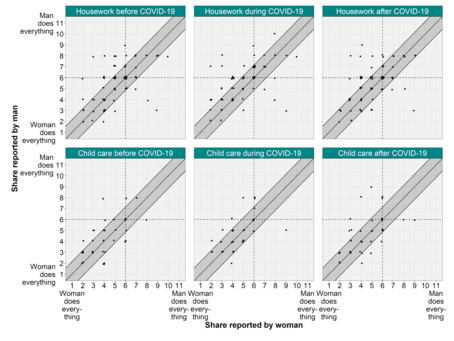#4 Blog: Do you know what I actually did?
COVID-19 has turned our everyday lives upside down. Due to the lockdown and the closure of child care facilities such as crèches, kindergartens and schools, the extent of child care increased significantly. But even households without children were occupied with more cooking (and buying groceries for it), more tidying, etc. In general, the measures to combat the spread of COVID-19 have led to an increase in the volume of unpaid work. The question that now arises for us is whether this has also led to a change in the division of labour.
We asked the participants of the questionnaire about the distribution of housework and child care before the lockdown and at the time of the survey (during COVID-19). In addition, we wanted to know how they estimate the distribution after the COVID-19 restrictions (return to regular work, normal opening hours of child care facilities, etc.). The respondents were able to describe the distribution on a scale between 0 (I do everything) and 10 (my partner does everything). To make the comparison easier, the answers for the analysis were re-coded to 1 (woman does everything) and 11 (man does everything).
In a first step, however, we do not examine to what extent the distribution has changed due to COVID-19, but whether men and women in couple households agree on how unpaid work is actually distributed between them. As in the previous blog post, the following evaluation only refers to those 82 couple households where both filled out the questionnaire and the answers could be linked with the help of a random PIN-code.
Figure 1: Distribution of housework and child care according to the assessment of women and men
Distribution of unpaid work before, during and after COVID-19
Figure 1 shows the respondents' assessment of how housework and child care are distributed in the household. Couple households on the 45° degree line (shown as dots), are households where both partners agree on how the unpaid work is distributed. The dark gray area shows all those couple households with information deviating only slightly (+ -1). For instance, the female partner describes the division as 5 (she does slightly more than 50/50), while the male partner reports the division as 4 (she does notably more than 50/50).
The analysis shows that around a third of couple households agree on the distribution of housework before and during COVID-19. A little more – around 40% – do have the same expectations regarding the future distribution of housework. In general, the couples describe the distribution relatively similarly: Around three quarters of all couples surveyed agree or more or less agree (+ -1) on how the distribution of housework before and after COVID-19 was or will be. When it comes to the distribution of housework at the time of the survey, the agreement rate is slightly lower at two thirds.
Around one third of the 38 parent-couple households share the same view on how child care is divided between them. Interestingly, the agreement (+ -1) on the distribution of child care at the time of the survey (during COVID-19) is highest at around 80%. For “before” and “after” COVID-19, the match is at around two thirds.
“I do more” – “No, I do more”
We find those couples particularly interesting where the understanding of who does more housework or child care is diametrically different (e.g. woman says she does more while man says he does more). These households are located in the figures in the upper left quadrant or in the lower right quadrant. In 6 households men think that they did more housework than their partner before COVID-19, while the associated partner was convinced that the opposite holds true (upper left quadrant). In the lower right quadrant, there are 3 couples, where men indicate that their partner did more before COVID-19, while the respective women believed that they did less housework than their partners. For the distribution at the time of the survey, there are only 7 couple households whose perception is diametrically different.
When it comes to child care, there are only a few households with different understandings of their distribution of unpaid work. In general, child care within the 38 couple households was primarily provided by mothers before COVID-19, with the exception of one couple. This man stated that he also is primarily responsible for the children during COVID-19. His partner, however, believes she has taken on more child care during the lockdown.

Conclusion
In general estimates of most couple households are very similar and large deviations are rare. There are only a few households where the partners disagree on who bears the larger burden of the unpaid work. However, one of the results of our survey may also be that they discussed their division of labour and that the partner's assessments are now being revised.
